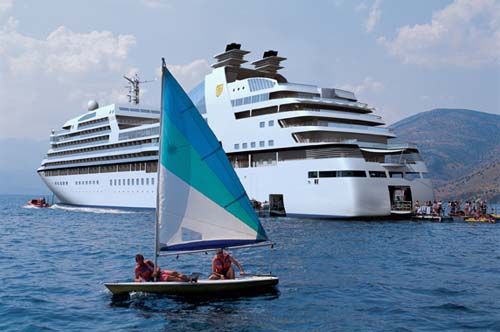 Page last updated at 01:09 GMT, Tuesday, 26 January 2010
Page last updated at 01:09 GMT, Tuesday, 26 January 2010
A week ago China's first gay pageant was cancelled, on orders from the police.
The event had been hailed as a new chapter of openness towards the gay community in China, where homosexuality was illegal until 1997 and defined as mental disorder until 2001.
Here three gay men in China describe the pressures they have to live with and the compromises they have to make.
Michael Tsai, 23, restaurant manager, Beijing

I was going to be the host for the gay pageant Mr Gay China, but unfortunately the government has once again oppressed its people silently. It would have been a wonderful step but there is much more fear than understanding.
Although I wouldn't call it discrimination, there's definitely a pressure to conformity in Chinese society. The goal is to to marry and produce male offspring. Since the Chinese are allowed to have only one child there is even more pressure to conform.
Thankfully I come from a family of two boys and the need to carry on the family name has already been fulfilled. I am out to all my family, my friends and colleagues.
Although I do feel that the country as a whole has become a lot more tolerant, it isn't necessarily more understanding.
My family feels that if something is not spoken about then it either doesn't exist or it will be forgotten. Even though they know I'm gay they still say things like "When you find your wife..."
I'm sure my parents are not thrilled by my sexual orientation but they seem to be dealing with it through denial and that's perfectly fine with me.
China has become a get-rich-fast society, a society where you build up power and forget about everyone else. There are more things to worry about than who's attracted to who.
Most of the older Chinese feel that being gay is just a phase and that eventually it will work itself out.
I don't feel that there are any problems in China that I've come across. If we aren't too loud and proud about it then the subject doesn't even cross anyone's mind.
Although I do feel that the country as a whole has become a lot more tolerant, it isn't necessarily more understanding.
Anonymous man, Guangzhou
I'm 35, I work as an environment researcher and I am married with two children. I am also gay.

Organisers hoped the pageant would mark a step towards greater awareness
I come from the countryside, where most people don't even know what gay means.
Several years ago, I came out to my three closest friends. I haven't, and will never, come out to my parents, wife and children.
There's a strong tradition in China you can't go against - to get married. I think most of the gay people in China are married. There's a lot of pressure from the family to do that.
The Chinese family is very traditional and it's not based on so-called love. My wife and I have a good relationship, we love each other like a brother and sister. I am happy in my family, we are the true family.
I don't need freedom. I need to keep this secret, so that I can live normally.
We need to keep to that, but I also have the freedom to make friends outside. Me and my gay friends have our own meetings, we go to a badminton club and have dinner together. That's all I need.
Happiness is not about desiring things you cannot have, but enjoying the things you have.
I have two children, one three-year old boy and an eight-year old girl. I would never come out to them - I don't want them to know that I am gay.
I hope that my children can have a normal life and I think to be gay is not normal because it's different from everybody else. I've accepted what I am because I cannot change.
I support our government's decision to cancel the gay pageant. Freedom is perhaps the most important thing in the Western world, but for us Chinese people, the most important thing is harmony.
I don't need freedom. I need to keep this secret, so that I can live normally.
There has been a change of attitude lately towards homosexuality, there's more acceptance and understanding. There's still lots of prejudice but I think it will take time for that to be eliminated.
Miles, 30, Shenyang
I was born in a small village in Liaoning Province in north-east China. Currently I work for a China-based multinational in Dubai, but I go back to China every four months.

Last year, China's first gay pride festival was praised in the state media
I have been in a relationship with a guy since I started working in Shenyang in 2001. We now live apart because of my current job.
I've never come out to my colleagues, family and friends. In my opinion, keeping a low profile is the real way of life, especially when your sexual preference is not the mainstream one.
Both my father and sister met my boyfriend, which is kind of dangerous. I am afraid one day they might discover that I am gay. I won't come out to them, as I don't want to hurt them.
In my opinion, the younger generations are more open to homosexuality than the older ones.
There is one problem all gay people face in China - that's marriage.
I wish to stay abroad, so that I can escape the fate of having to start a family.
This tradition is deeply rooted in most Chinese people's minds. The pressure is particularly strong on those born in a one-child family as they have to fulfil their God-given mission to maintain the family continuity.
I am trying to stay far away from marriage. While I am in Dubai, I don't sense the pressure from my family for the time being. But that day will come if I return to China. I wish to stay abroad, so that I can escape the fate of having to start a family.
With the young generations growing into adults, I believe Chinese society will become more tolerant towards homosexuality. I have young friends who don't care at all.
Even though homosexuality is legal, large-scale events are still not possible. But in our everyday life gay people are, in most cases, accepted by their close peers and colleagues because most gay people are friendly and have good personalities.
We have many gay websites, we have gay night clubs in the big cities and we have a professor of a top Chinese university, named Li Yinhe, who is an advocate of gay rights.
China is changing to accept new ideas and develop in many different areas and so I believe that one day gay marriage will become legal.
View Article in BBC News



 01.25.10, 11:51 PM EST
01.25.10, 11:51 PM EST 






 All these constructions are called Fortress. There is no consistent version according to that, who has built it. Some people are sure that it was Japanese invaders (in the war between Russia and Japan in 1905 – 1907). Others suppose it was Gulag prisoners. Almost all would tell stories about the builders, mured in the walls of the Fortress. I hope the legends like this are simply influenced with ones about construction of the Great Chinese Wall:
All these constructions are called Fortress. There is no consistent version according to that, who has built it. Some people are sure that it was Japanese invaders (in the war between Russia and Japan in 1905 – 1907). Others suppose it was Gulag prisoners. Almost all would tell stories about the builders, mured in the walls of the Fortress. I hope the legends like this are simply influenced with ones about construction of the Great Chinese Wall:  The Fortress consists of forts, breast-works, defensive ditches, casemated spaces and military barracks, connected with each other with underground corridors. The walls and vaults are incredibly thick and mighty. The tourists, visiting the fortification constructions on the Russkiy Isle walk more than one kilometer under ground only. The system of the underground connecting tunnels of the Fortress is really very sophisticated and developed. Unfortunately, the Fortress looks not so good it could, because of the years of breakdown of the late 80-s – 90-s. Some pieces of artillery of the early 20th century have however, survived and are to be observed. Moreover, they function. These guns had an outstanding level of accuracy of aim. The buoy moorings with diameter of 2 meters was annihilated during the last practice fire (1992) from the distance of 6 sea miles (1 sea mile contains 1852 meters). With the other words, the gun target was almost invisible with the naked eye.
The Fortress consists of forts, breast-works, defensive ditches, casemated spaces and military barracks, connected with each other with underground corridors. The walls and vaults are incredibly thick and mighty. The tourists, visiting the fortification constructions on the Russkiy Isle walk more than one kilometer under ground only. The system of the underground connecting tunnels of the Fortress is really very sophisticated and developed. Unfortunately, the Fortress looks not so good it could, because of the years of breakdown of the late 80-s – 90-s. Some pieces of artillery of the early 20th century have however, survived and are to be observed. Moreover, they function. These guns had an outstanding level of accuracy of aim. The buoy moorings with diameter of 2 meters was annihilated during the last practice fire (1992) from the distance of 6 sea miles (1 sea mile contains 1852 meters). With the other words, the gun target was almost invisible with the naked eye. 



 Workers ride past cooling towers at a coal-fired power plant on the outskirts of Beijing. Such power plants are at the center of a debate about the future of energy production in China and the U.S. Frederic J. Brown/AFP/Getty Images
Workers ride past cooling towers at a coal-fired power plant on the outskirts of Beijing. Such power plants are at the center of a debate about the future of energy production in China and the U.S. Frederic J. Brown/AFP/Getty Images Page last updated at 01:09 GMT, Tuesday, 26 January 2010
Page last updated at 01:09 GMT, Tuesday, 26 January 2010



 To date, I have sailed on the
To date, I have sailed on the 
 01.25.10, 09:51 PM EST
01.25.10, 09:51 PM EST 
![[SB10001424052748703808904575025593042490112]](http://s.wsj.net/public/resources/images/ED-AK871_skyscr_D_20100125165829.jpg)

 Jan 25 08:51 AM US/Eastern
Jan 25 08:51 AM US/Eastern




